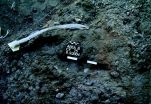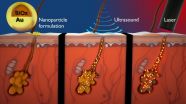(Press-News.org) The Canadian research community on high-temperature superconductivity continues to lead this exciting scientific field with groundbreaking results coming hot on the heels of big theoretical questions.
The latest breakthrough, which will be published March 20 in Science, answers a key question on the microscopic electronic structure of cuprate superconductors, the most celebrated material family in our quest for true room-temperature superconductivity.
This result is the product of a longstanding close collaboration between the University of British Columbia Quantum Matter Institute and the Canadian Light Source. In fact, this is the third Science paper to come out of this remarkably fruitful collaboration this past year, and the first to feature an all-Canadian effort.
The collaborators work at the forefront of research into high-temperature superconductors, an exciting class of materials exhibiting superconductivity at temperatures as comparatively warm as -100?C. As frigid as such temperature may sound, it outperforms by far traditional superconductors, which operate at closer to -270?C, or a few degrees from absolute zero - the point where all motion stops."
In the superconducting state, electricity flows with absolutely no resistance, which means no energy is lost and no heat is generated. Combined, these properties allow for large 'supercurrents' that could not be realized in ordinary wires.
For this reason, superconductors are already used to provide the large magnetic fields needed for Magnetic Resonance Imaging, but the cooling systems needed to make them work are costly and impede other potential uses. Some of the major, transformative applications of room-temperature superconductivity include magnetic levitation trains and lossless power lines. (Imagine getting rid of that pesky delivery charge on your energy bill--room temperature superconductivity could make it possible.)
The paper's lead author, Riccardo Comin, a UBC graduate from Andrea Damascelli's group and now a post-doctoral fellow at the University of Toronto, compares the movement of electrons in a superconductor to birds flying in formation, coherently and without collisions. In physics-speak, the electrons move coherently and in phase, and no energy is lost as they drift smoothly along.
In cuprate superconductors, another state blocks and interacts with superconductivity: the charge-density-wave, in which the electrons assume a static pattern, different from the pattern that the material's crystal structure defines.
You can also think of the superconducting electrons like cars on a highway, all moving the same speed and direction, the picture of efficiency. But the charge-density-wave state acts like a patterned traffic jam: no movement, anywhere.
Understanding what causes this pattern is thought to be a key step to understanding superconductivity, but even pinning down the nature of the pattern has been elusive. Major theoretical models predict either a parallel line structure, or a checkerboard pattern. Unfortunately, even with advanced synchrotron techniques, it has proved impossible to see the difference between the two models.
That is, until Comin's latest results in Science, which show that the cuprate superconductor in question has a stripe-like pattern rather than a checkerboard one. The UBC-CLS team used an unconventional experimental approach to reconstruct a 2-dimensional model of the static electron pattern from 1-dimensional scans--much like the tomographic reconstructions used for medical purposes.
These results offer new fundamental insights helping hone the search for room temperature superconductivity. However, more challenging questions remain. Among these puzzles: What is the driving force behind the tendency of electrons to move together coherently in the superconducting state, and how can the superconductivity transition temperature be further enhanced? Despite almost 30 years of history, the field of high temperature superconductivity is more alive than ever.
INFORMATION:
Some 2.5 million years ago, early humans survived on a paltry diet of plants. As the human brain expanded, however, it required more substantial nourishment - namely fat and meat - to sustain it. This drove prehistoric man, who lacked the requisite claws and sharp teeth of carnivores, to develop the skills and tools necessary to hunt animals and butcher fat and meat from large carcasses.
Among elephant remains some 500,000 years old at a Lower Paleolithic site in Revadim, Israel, Prof. Ran Barkai and his graduate students Natasha Solodenko and Andrea Zupanchich of Tel ...
DENVER, March 23, 2015 -- Since HIV emerged in the '80s, drug "cocktails" transformed the deadly disease into a manageable one. But the virus is adept at developing resistance to drugs, and treatment regimens require tweaking that can be costly. Now scientists at the 249th National Meeting & Exposition of the American Chemical Society (ACS) are announcing new progress toward affordable drugs that could potentially thwart the virus's ability to resist them.
ACS, the world's largest scientific society, is holding the meeting here through Thursday. It features nearly 11,000 ...
Washington, D.C.--To combat global climate change caused by greenhouse gases, alternative energy sources and other types of environmental recourse actions are needed. There are a variety of proposals that involve using vertical ocean pipes to move seawater to the surface from the depths in order to reap different potential climate benefits. A new study from a group of Carnegie scientists determines that these types of pipes could actually increase global warming quite drastically. It is published in Environmental Research Letters.
One proposed strategy--called Ocean ...
What if there were a pill that made you more compassionate and more likely to give spare change to someone less fortunate? UC Berkeley scientists have taken a big step in that direction.
A new study by UC Berkeley and UC San Francisco researchers finds that giving a drug that changes the neurochemical balance in the prefrontal cortex of the brain causes a greater willingness to engage in prosocial behaviors, such as ensuring that resources are divided more equally.
The researchers also say that future research may lead to a better understanding of the interaction between ...
URBANA, Ill. - Over the last several decades there have been substantial yield improvements in soybean. Because of new varieties and new agronomic practices, the yield potential in soybean is higher now than ever before. But a lack of updated information on the nutritional needs of soybean crops may be limiting the crop's potential.
Researchers from the University of Illinois Crop Physiology Laboratory led by Fred Below have recently provided an updated set of nutrition needs for soybean, identifying exactly which nutrients the plant needs, when those nutrients are accumulated ...
Acne, a scourge of adolescence, may be about to meet its ultra high-tech match. By using a combination of ultrasound, gold-covered particles and lasers, researchers from UC Santa Barbara and the private medical device company Sebacia have developed a targeted therapy that could potentially lessen the frequency and intensity of breakouts, relieving acne sufferers the discomfort and stress of dealing with severe and recurring pimples.
"Through this unique collaboration, we have essentially established the foundation of a novel therapy," said Samir Mitragotri, professor ...
Our eyes are drawn to several dimensions of an object--such as color, texture, and luminance--even when we need to focus on only one of them, researchers at New York University and the University of Pennsylvania have found. The study, which appears in the journal Current Biology, points to the ability of our visual system to integrate multiple components of an item while underscoring the difficulty we have in focusing on a particular aspect of it.
"Even when we want and need to focus on one dimension of things we come across every day, such as the texture of your cat's ...
For in vitro fertilization and other assisted reproductive technologies, selecting the healthiest and best swimming sperm from a sample of semen can dramatically increase success. Microfluidics--micro-scale technologies that were originally developed to enable high-throughput gene sequencing and for Point-Of-Care diagnostics--are now being adapted to enhance sperm sorting. These new methods, reviewed by engineers in the journal Trends in Biotechnology, are generating promising results in applications such as single-sperm genomics, in-home male fertility testing, and wildlife ...
A combination of human stem cell transplantation and antidiabetic drugs proved to be highly effective at improving body weight and glucose metabolism in a mouse model of type 2 diabetes. The findings, published March 19th by Stem Cell Reports, could set the stage for clinical trials to test the first stem cell-based approach for insulin replacement in patients with type 2 diabetes.
Type 2 diabetes, which accounts for 90%-95% of the now approaching 400 million cases of diabetes worldwide, is currently treated by oral medication, insulin injections, or both to control blood ...
Altered signaling through the vitamin D receptor on certain immune cells may play a role in causing the chronic inflammation that leads to cardiometabolic disease, the combination of type 2 diabetes and heart disease that is the most common cause of illness and death in Western populations. The research appears March 19 in the journal Cell Reports.
"Because low vitamin D levels are associated with diabetes and heart disease, we looked at the connections between vitamin D, immune function, and these disease states," says senior author Carlos Bernal-Mizrachi, of the Washington ...


